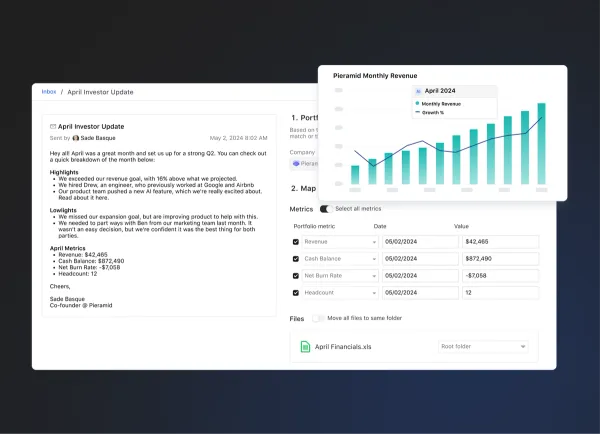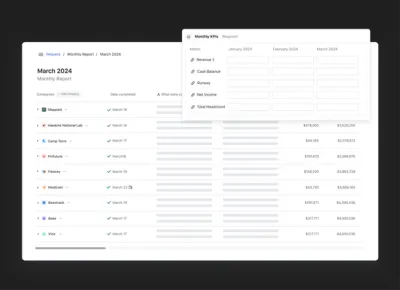
Raising capital from investors can be one of the most challenging tasks for founders. Generating interest, building relationships, and making a compelling case for investment can often seem overwhelming. To overcome these challenges, founders are increasingly turning to investment memos. These concise documents effectively outline crucial information that helps investors build conviction in a business.
In this guide, we'll cover everything you need to know about crafting an investment memo, from tips and templates to step-by-step instructions. Whether you're a first-time founder or an experienced entrepreneur, this guide will help you create a powerful investment memo that showcases your potential and seriousness about fundraising.

What is an Investment Memo?
An investment memo, or investment memorandum, is a structured document used to pitch a company, project, product, or strategy to potential investors. It provides a clear and concise presentation of the strategic vision, rationale, and expectations for the investment. Unlike a pitch deck, which often relies heavily on visuals and brief points, an investment memo delivers a more detailed and comprehensive narrative, helping investors understand the full scope of the opportunity.
Why Are Investment Memos Important?
Investment memos are vital tools in the fundraising process. They serve multiple purposes and provide significant advantages for both founders and investors:
Building Conviction
Investment memos enable stakeholders to develop strong convictions about an idea or business. By presenting detailed information and a well-structured argument, memos help potential investors understand the merits and potential of the investment.
Fostering Relationships
Investment memos can be instrumental in building relationships with investors. Clearly articulating why someone should invest in your startup helps make quick decisions and demonstrates respect for the investor's time and sets the tone for future communications.
Ensuring Alignment
Investment memos create alignment among all stakeholders. For those raising capital, memos keep current and potential investors informed and in sync with your messaging and round status. Within a team, memos ensure everyone is on the same page regarding decisions and project progress, providing a reference point for future discussions.
Related resource: Contributed Capital
Types of Investment Memos
In the context of venture capital, investment memos serve several specific purposes. By understanding these different types of memos, founders can better tailor their documents to meet the expectations and needs of venture capital investors.
- Pre-Investment Memos: Prepared by founders to attract venture capital, these memos outline the business opportunity, market potential, and strategic vision to convince investors to fund their startup.
- Due Diligence Memos: Created by venture capital firms, these documents detail their analysis and findings on a potential investment, including market analysis, competitive landscape, and financial projections.
- Internal Investment Proposals: Used within venture capital firms to present and justify investment opportunities to partners and decision-makers, ensuring everyone is aligned on the potential benefits and risks.
- Post-Investment Memos: These documents summarize the terms of the investment and the expected milestones and performance metrics, serving as a reference for both the investors and the founders.
Who is Reviewing Investment Memos?
Investment memos are reviewed by a variety of audiences, each with their own perspectives and priorities. Understanding who will be reading your memo is crucial to crafting a document that meets their needs and expectations.
To be successful, investment memos need to be clear, concise, and tailored to the specific concerns and interests of these audiences. Providing relevant data, logical arguments, and a compelling narrative will help engage and persuade potential investors.
- Venture Capitalists (VCs): These are the primary audience for investment memos. VCs are looking for compelling business opportunities with strong growth potential. Your memo should clearly articulate the market opportunity, competitive landscape, financial projections, and the unique value proposition of your business.
- Angel Investors: Similar to VCs but often investing at an earlier stage, angel investors seek high-potential startups that align with their investment criteria. The memo should emphasize the innovative aspects of your product or service, early traction, and the founding team's expertise.
- Internal Stakeholders: Within a venture capital firm, partners and analysts will review the memo to evaluate the investment's merits. The memo should provide thorough analysis and data to support the investment thesis, making it easy for internal stakeholders to present and defend the opportunity to the investment committee.
- Corporate Investors: Corporations looking to invest in startups for strategic reasons will review the memo to assess how the startup aligns with their business objectives and strategic goals. Highlighting potential synergies, strategic fit, and long-term benefits is essential for this audience.
- Board Members and Advisors: For companies seeking internal investment or approval for a new project, board members and advisors will review the memo. They will focus on how the investment aligns with the company's overall strategy, potential risks, and expected returns.
- Potential Co-Investors: Other investors who might join the funding round will also review the memo. It's important to present a clear and attractive investment opportunity, demonstrating strong market potential and a well-defined growth strategy.
Pitch Deck vs Investment Memo
Both pitch decks and investment memos are essential tools in the fundraising process, but they serve different purposes and offer unique advantages. Understanding when to use a pitch deck versus an investment memo is key. Pitch decks are ideal for initial pitches and quick overviews, while investment memos are better suited for detailed follow-ups and in-depth evaluations.

Control Your Story
A pitch deck relies heavily on visuals and bullet points to tell your story quickly, often requiring the founder to provide verbal context during a presentation. This can sometimes lead to misinterpretation if the deck is shared without explanation. In contrast, an investment memo provides a detailed narrative that stands on its own, ensuring that all key points and context are clearly communicated without the need for additional explanation.
Quick Decisions
Pitch decks are designed for quick consumption, allowing investors to rapidly understand the business at a high level. They facilitate fast decision-making, especially in initial meetings. Investment memos, while more detailed, allow investors to thoroughly evaluate the opportunity on their own time. This thoroughness can lead to more informed and confident decisions, albeit at a potentially slower pace than a pitch deck.
Succinct
Pitch decks are inherently succinct, typically consisting of 10-15 slides that highlight the most critical aspects of the business. This brevity is useful for capturing attention and providing a snapshot of the opportunity. Investment memos, while still concise, delve deeper into each aspect of the business, offering comprehensive insights that are crucial for serious consideration and due diligence.
What Should Be Included in an Investment Memo?
Creating an effective investment memo involves including several key components that together provide a comprehensive picture of your business and its potential. Here’s what you should include:
Purpose
Clearly state the objective of the memo. Are you seeking investment, strategic partnerships, or approval for a new project? Define what you hope to achieve and why the reader should care. This section should succinctly capture the essence of your request and its significance.
Problem
Identify the problem or pain point your business addresses. Explain why this problem is significant and worth solving. Highlight the current challenges and inefficiencies in the market that your product or service aims to overcome.
Solution
Describe your solution to the identified problem. Detail how your product or service works, what makes it unique, and why it is superior to existing solutions. Emphasize the value proposition and the benefits it provides to customers.
Market Size
Provide an analysis of the market size and potential. Include data on the total addressable market (TAM), the serviceable available market (SAM), and your serviceable obtainable market (SOM). This helps investors understand the scale of the opportunity and the potential for growth.
Competition
Analyze the competitive landscape. Identify key competitors and their strengths and weaknesses. Explain how your business differentiates itself from the competition and the strategic advantages you hold. Highlight any barriers to entry that protect your position in the market.
Product Development
Detail the current state of your product development. Include information on the product roadmap, milestones achieved, and future plans. Explain how the capital you are raising will be used to advance product development and achieve key objectives.
Sales and Distribution
Outline your go-to-market strategy. Describe your sales and distribution channels, marketing plans, and any strategic partnerships. Provide data on customer acquisition costs (CAC), lifetime value (LTV), and sales traction to date.
Metrics
Present key performance metrics that demonstrate your business’s progress and potential. Include data on revenue growth, user engagement, customer retention, and other relevant metrics. Use charts and graphs to make this information easily digestible.
Team
Introduce your team and highlight their qualifications and expertise. Explain why your team is uniquely positioned to execute the business plan and achieve success. Include information on key advisors and board members who bring additional value and credibility.
Tips for Building Your Investment Memo
Creating an effective investment memo requires careful attention to clarity, succinctness, impact, use of visual aids, and crafting a compelling narrative. Here’s how you can achieve these key elements:
Importance of Clarity, Succinctness, Impact, Use of Visual Aids, and Narrative
- Clarity: Ensure your memo is easy to understand. Avoid jargon and complex language. Clear communication helps investors quickly grasp the essentials.
- Succinctness: Be concise. Investors are busy and appreciate memos that get to the point without unnecessary details.
- Impact: Highlight the most compelling aspects of your business. Make a strong case for why investors should care.
- Use of Visual Aids: Visual aids such as charts, graphs, and images can make complex information more digestible and memorable.
- Narrative: Tell a story that engages the reader. A well-crafted narrative can make your memo more persuasive and relatable.
Best Practices
- Be Clear and Concise:
- Use simple, straightforward language.
- Avoid unnecessary details that do not add value.
- Support Your Claims with Data:
- Include relevant data and metrics to back up your claims.
- Use charts and graphs to present data clearly.
- Tailor the Memo to Your Audience:
- Understand what your audience cares about and address those points.
- Highlight aspects of your business that align with their interests and concerns.
Mistakes to Avoid
- Overloading with Information:
- Avoid including too much information, which can overwhelm the reader.
- Focus on the most critical points.
- Ignoring Visual Aids:
- Don’t neglect the power of visual aids to enhance understanding.
- Use visuals to break up text and illustrate key points.
- Failing to Address Risks:
- Be transparent about potential risks and challenges.
- Show that you have a plan to mitigate these risks.
Using Visual Aids
- Charts and Graphs:
- Use bar charts, line graphs, and pie charts to present financial data and market analysis.
- Infographics:
- Create infographics to summarize complex information or processes.
- Product Images or Prototypes:
- Include images of your product or screenshots of your software to give a tangible sense of what you are offering.
Crafting Your Narrative
- Start with a Compelling Story:
- Begin with a strong opening that captures the reader’s interest and sets the stage for your business case.
- Highlight Key Milestones and Successes:
- Showcase significant achievements and milestones that demonstrate your progress and potential.
- Clearly Outline Your Vision for the Future:
- Paint a clear picture of your long-term vision and how the investment will help achieve it.
Tips for Presenting Your Investment Memo
Delivering a compelling presentation of your investment memo is crucial for persuading potential investors. Here are some tips to improve your presentation delivery:
1. Master Your Vocal Timbre
- Vocal Clarity: Speak clearly and at a moderate pace. Ensure your voice is audible to everyone in the room.
- Tone Variation: Use a dynamic tone to emphasize key points and keep the audience engaged. Avoid a monotone delivery which can be boring.
- Volume Control: Adjust your volume to suit the size of the room and the number of attendees. Ensure you are neither too loud nor too soft.
2. Use Pauses Effectively
- Emphasize Key Points: Pause briefly after making important statements to allow the audience to absorb the information.
- Avoid Filler Words: Use pauses instead of fillers like "um," "uh," or "like." This makes you appear more confident and in control.
- Natural Breaks: Incorporate natural pauses at the end of sentences and between sections to give yourself and the audience a moment to reflect.
3. Incorporate Anecdotes
- Personal Stories: Share relevant personal experiences that illustrate your passion and commitment to the business.
- Customer Stories: Use anecdotes from customers or clients to demonstrate the impact and value of your product or service.
- Investor Success Stories: Mention past successes or case studies of investors who have benefited from similar opportunities.
4. Cast a Vision for the Future
- Future Goals: Clearly articulate your long-term vision and how the investment will help achieve these goals.
- Big Picture: Help investors see the broader impact of their investment, including market transformation and potential returns.
- Inspirational Messaging: Use inspirational language to motivate and excite your audience about the future possibilities.
Great Investment Memo Examples
Examining successful investment memos can provide valuable insights into what works well and why. These examples highlight the importance of clarity, thoroughness, and strategic foresight in creating an effective investment memo. By following similar principles, you can craft a memo that resonates with investors and effectively communicates your business's potential. Here are two notable examples:
The Y Combinator Investment Memo
Why it works:
- Clear Articulation of Metrics and Growth:
- The memo clearly presents key metrics and growth statistics, making it easy for investors to understand the business's current performance and potential.
- Addressing Challenges Proactively:
- It identifies potential challenges and how the company plans to overcome them, showing foresight and preparedness.
- Market Opportunity Excitement:
- The memo effectively communicates the market opportunity, generating excitement about the potential for success.
- Preemptive Question Handling:
- It uses insights from previous investor interactions to address common questions and objections upfront, streamlining the evaluation process.
The YouTube Investment Memo
Why it works:
- Real-Life Example from a Successful Tech Company:
- The memo provides a real-world example from a proven and successful tech company, lending credibility and relatability.
- Detailed Growth and Future Modeling:
- It includes thorough growth projections and future models, helping investors understand the long-term potential.
- Facilitates Decision-Making:
- The memo is structured to simplify the decision-making process for investors, making it easy to share and discuss within the investment firm.
- Concise and Informative:
- It strikes a balance between being comprehensive and concise, providing all necessary information without overwhelming the reader.

Helpful Investment Memo Templates
Using templates can streamline the process of creating an effective investment memo. These templates provide a structured approach to crafting investment memos, tailored to different business needs and stages. By choosing the right template, you can ensure your memo effectively communicates your business's value and potential to investors. Here are some useful templates and who they are best suited for:
Y Combinator Investment Memo
Best for:
- Founders Raising Venture Capital:
- Ideal for startups seeking to attract venture capital investment.
- Founders with Strong Writing Skills:
- Suitable for those who can effectively communicate their business model and growth plans in writing.
- Early-Stage Companies:
- Great for companies at an early stage looking to clearly articulate their vision and market potential to investors.
Executive Team Strategic Memo
Best for:
- Growing Executive Teams:
- Beneficial for companies with expanding executive teams that need improved communication and alignment.
- Remote or Distributed Teams:
- Ideal for businesses that operate remotely and require asynchronous communication tools.
- Companies Focused on Strategic Planning:
- Useful for organizations that rely on quarterly or annual planning to set objectives and track progress.
The EVERGOODS Product Brief
Best for:
- Product-Driven Businesses:
- Perfect for companies where product development and innovation are key drivers of success.
- Companies Prioritizing Customer Feedback:
- Ideal for businesses that need to prioritize customer feedback and product features in their development roadmap.
- Articulating Future Product Development:
- Suitable for companies that want to clearly outline what features are in the pipeline and the reasons behind their development.
Get Started With Investment Memo Templates from Visible
Ready to craft your investment memo? To make the process easier, we've compiled a library of the best investment memo templates available. These templates are designed to help you effectively communicate your business's potential and secure the investment you need.
Not sure where to start? Check out the investment memo template from Y Combinator below, or explore other options tailored to different business needs. These templates will guide you in creating a clear, concise, and compelling investment memo that resonates with investors.
Use the YC Memo Template
By leveraging these templates, you can streamline your fundraising efforts and present your business in the best possible light. Get started today and take the first step towards securing your next round of funding.
Related resource:




